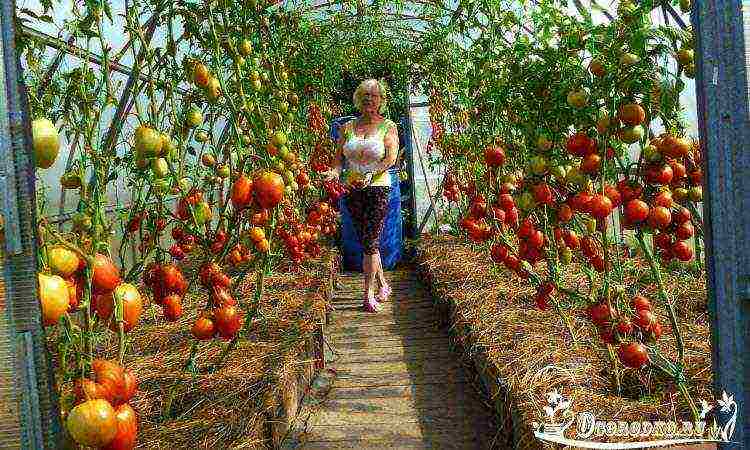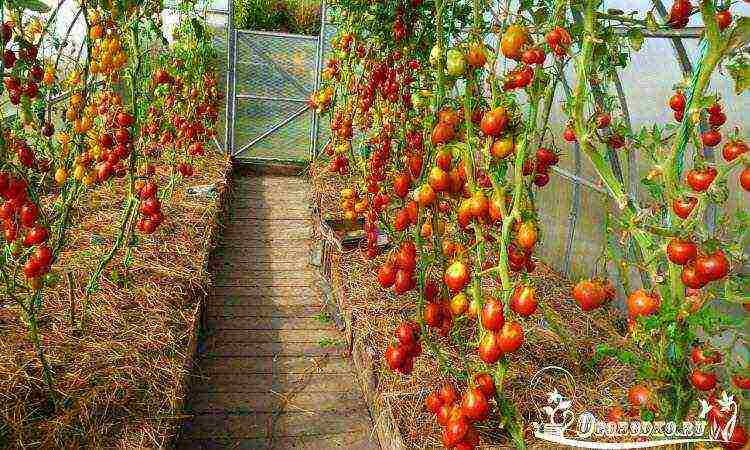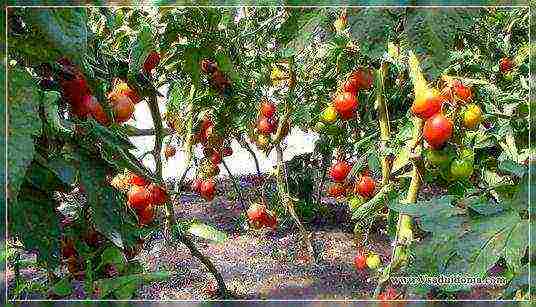Content [show]
Does the quality of the tomato depend on the variety, or the whole point is in dressing
The main thing in growing tomatoes is proper agricultural technology. A lot depends on the variety, but not everything. Sometimes they write bad reviews about the variety, that the tomato is tasteless, low-yielding with a plastic taste, and even painful. And then the person adds: "I didn't feed anything."
It comes as no surprise that a malnourished person has health problems, dull split ends and a pale appearance. But plants also have certain requirements.
And our soils are by no means ideal in themselves. Therefore, in order to get a good harvest, you must follow the necessary agricultural practices. This does not mean that you need to fill everything with a variety of chemistry or endlessly complain that it is impossible to get organic matter. Fermented weeds from your own garden, ash, compost can become an elementary fertilizer.
And only having done everything that is possible to get a good harvest, you can judge a particular variety
... I spend the first feeding of my tomatoes 3 weeks after planting in this way: 0.5 cups of Ideal per 10 liters of water and pour 0.5 liters under the plant. Subsequent feeding is alternated after 10 days. - I stir a 0.5-liter can of ash in 10 liters of water, insist for 12 hours, and then use the settled water - pour 1 liter under the bush.
I throw out the sediment under the berry bushes.
- The next top dressing is done with nettle infusion with mullein. To do this, I fill half a bucket with fresh nettles, add a fresh cow cake, fill it with water, cover it with a film, insist for 7-10 days, stir occasionally. I dilute the resulting solution - 1 liter in a bucket of water - and put 1 liter of solution under the bush. Lydia Ivanova-Krichinevskaya. St. Petersburg. Photo by the author.

Tall tomatoes are gaining great popularity among summer residents and gardeners. And the reason for this is the unrestricted growth of the leading stem, which can reach a height of two to seven meters in 4-6 months. Those who want to save space on the site and collect excellent tomatoes in large quantities, simply cannot do without tall varieties.
Growing Tall Tomatoes - Key Benefits
Indeterminate tomato varieties have a number of advantages that can be appreciated already in the first year of planting:
- the most important advantage of such varieties and hybrids is certainly the saving of land space on the site, since you can plant fewer plants, but at the same time not lose in the harvest;
- the use of vertical space allows you to increase the number of ovaries and inflorescences, and, accordingly, the yield from such tomatoes is guaranteed to be greater. On one bush, 8-10 clusters with tomato fruits can ripen at the same time;
- plants are evenly illuminated and there is good air access, therefore, tomatoes are more resistant to late blight and various diseases;
- the fruiting of tall tomatoes is longer and can last up to six months, and when grown in greenhouses and adherence to agricultural technology, generally up to a year;
- such tomato plantings will decorate your site, as they look very organic and beautiful.
Growing technique for tall tomatoes
Growing tall tomatoes begins with proper soil preparation and planting. You can prepare the beds in the fall. In the spring, you can also do this, but no later than thirty days before planting the seedlings. Since tomatoes love fertile soil, it is recommended to add humus, peat, or compost.
 in the photo - tall (indeterminate) tomatoes by Lydia Ivanova-Krichinevskaya
in the photo - tall (indeterminate) tomatoes by Lydia Ivanova-Krichinevskaya
Potassium and phosphorus trace elements should be applied in the fall and dug up. The soil is saturated with nitrogen fertilizers in the spring. If the soil is clay, add river sand and manure, so the earth will be looser. If possible, sow the garden with rye or mustard in the fall, when the siderates rise and grow, dig up. This will heal the earth and saturate it with useful substances.
If the sowing of tomato seeds has already been done and the seedlings are ready for planting in a permanent place, proceed with the planting process. It is very important when growing tall tomatoes to choose the correct planting scheme, do not place the plants too close to each other.
Planting seedlings in two rows in a checkerboard pattern will be optimal.
When forming tomatoes into one trunk, leave the distance between the tomatoes about half a meter. If the formation will take place in several stems, increase the intervals to 0.7-0.8 meters.
Indeterminate tomatoes must be pinned, giving the desired shape to the plant. Many people prefer not to do this, in which case the risk of growing green mass and a decrease in the size of the fruits and the crop itself increases. With too many tomatoes on the bush, their ripening is delayed, so many beginners in this matter simply do not have time to harvest by autumn.
Correct formation will provide you with good plant growth and timely ripening of fruits, and most importantly - gradual. The pleasure of growing tall varieties can be extended for the whole summer and autumn, subject to agricultural technology. When forming tomatoes into one trunk, you need to break out all the lateral shoots that grow below and above the first brush. In the month of August, stepchildren stop breaking off and pinch the top of the main stem. Feed the tomato regularly, keeping in mind that powerful and tall plants require fertilization.
 in the photo - growing tall (indeterminate) tomatoes in a greenhouse, the experience of Lydia Ivanova-Krichinevskaya
in the photo - growing tall (indeterminate) tomatoes in a greenhouse, the experience of Lydia Ivanova-Krichinevskaya
How to tie tall tomatoes?
Tall tomatoes definitely need support, it can be a trellis, cylinders or spirals made of metal mesh, or strong high stakes. Trellis, according to experienced agronomists, are the most successful designs for growing tomatoes.
When growing plants on a trellis, the seedlings are placed closer to the edge of the bed, and the transverse support is installed in the center. When the tomatoes begin to grow, a rope is stretched, one end of which is twisted a couple of times around the tomato, and the other is fixed on a support. As it grows, the growing stem is wrapped around a rope to prevent the plant from breaking.
The material for the garter of plants must be chosen non-slip. Use new ropes and garters, with old ones there is a risk of disease. When tying tomatoes, the rope should be slightly loose on the trunk, do not overtighten it.
Now you know how to tie tall tomatoes. Tomatoes require attention, do not be lazy if you want to grow tomatoes for everyone to envy!
Lydia Ivanova-Krichinevskaya: At your numerous requests, I am telling you about my agricultural technology of growing tomatoes FROM and TO.
SOWING
I sow tall plants in bowls at the end of February, semi-determinants and children - March 9-10 with a pick about 20 days after sowing.
Before sowing, I moisten the soil with a pink solution of potassium permanganate, then spray it with Energen's solution (the color of light beer). I soak the seeds (not processed) for 20 minutes in a pink solution of manganese for 20 minutes, then rinse them under running water, then soak them in the Epin solution (2 drops per 100 ml of water) for 6 hours, after which I sow without washing, to a depth of 1 cm.
I cover the pots with a perforated film and put them in a warm, dark place before germination (26-28 g).
A couple of days after sowing, I check in the morning and in the evening, so as not to miss the shoots.
As soon as the loops appear, I put them under 3-day lighting at a distance of 10-15 cm from the lamp.Then I keep the seedlings at a temperature of 16-18 grams during the day, and at night 13-15 grams for a week (so that the seedlings do not stretch out). Then I gradually increase the temperature to 20-22 grams.
Remember that seedlings need good lighting. I rarely water them, at the root. If you fill the seedlings, the seedlings will stretch out and may get sick with a "black leg"
I feed Fertika - luxury (1 teaspoon. Lodge X 10 liters of water), combining with watering, that is, I water it only with this kind of water.
Purchased soil for seedlings. I mix with coconut substrate (0.5 buckets of soaked coconut X 1 bucket of soil + 0.5 liters of a can of sifted ash).
I make a pick after 3 weeks in disposable 0.5 liter glasses, into which I pour the substrate up to half a glass. Then, as the seedling grows, I add it gradually to the edges of the glass.
PREPARATION OF BEDS IN THE GREENHOUSE
I prepare the beds for the new season in the fall. First, immediately after harvesting, I sow white mustard, and then, before flowering, when it reaches 15-20 cm, I mow it, leave it in the garden and cover it with ash (1 glass per 1 sq. M), then compost or humus on top (1 bucket for 1 square meter), I dig it up and spill it well with a solution of any EM preparation.
If the tomatoes are sick, you have to remove the top layer of soil, about 10 cm, then process the soil with copper sulfate (2 tablespoons per 10 liters of water X 10 sq. M.) Then ash + compost. I dig it up and spill it with phytosporin.
In the spring, a new gas station: I bring in 1 glass of ash, 2 tables per 1 square meter. lies. superphosphate, 1 table. lies. potassium sulfate. I close up the fertilizers with a flat cutter, level them and spill them with hot water with potassium permanganate. Then I cover the bed with a film to warm the soil (at least a week before planting).
PLANTING AND CARE OF TOMATOES
I make holes in 2 rows every 50 cm in a checkerboard pattern (bed width 110 cm). After creating the holes, I spill them well with hot water with potassium permanganate, add a handful of ash and ISPOLINA or good humus. I fall asleep lightly with soil and spill it again. Sometimes I put a good handful of nettles at the bottom of the hole (a lesson from my father-in-law!).
I plant 60-day seedlings in this way (the day before planting, I recommend spraying with Epin's solution (1 ml X 5 liters of water):
closer to the wall - determinants, and to the passage - tall.
I do not completely cover the planted seedlings with soil in the holes. I spill it well with warm water and mulch with peat so that moisture is kept and there is no crust. I do not water for 2 weeks, and then I spend abundant watering with warm water and add a little earth. Next, I carry out the filling gradually until the holes are equal to the level of the beds. I remove the leaves that touch the ground in order to avoid diseases.
I put arcs over the plants, onto which I throw spunbond on top, and on top I also throw a film. For the first 3 days, the bed should be shaded from the sun.
If it's cold at night, I put a heater under the arches.
When the warmth comes, you can remove the shelter and tie the tomatoes with twine, which is attached to a wire passed along the bed under the ceiling. I mulch the garden with dry hay, stepping back 10 cm from the stem.
FEEDING
I spend the first feeding of my tomatoes 3 weeks after planting: 0.5 cups of IDEAL per 10 liters of water X 0.5 liters under a bush. Subsequent feeding alternate after 10 days: I use a 0.5 liter can of ash for 10 liters. water, I insist 12 hours, and then pour 1 liter of settled water. under the bush. I throw out the sediment under the berry bushes. The next top dressing is done with nettle infusion with mullein. To do this, I fill half a bucket with fresh nettles, add a fresh cow cake, fill it with water, cover with a film, insist for 7-10 days, stir occasionally. I dilute the resulting solution - 1 liter in a bucket of water and add 1 liter each. solution under the bush.
CARE
I water the tomatoes once a week. This is quite enough, since the soil is mulched.
For better fruit setting, during the flowering of the second brush, I spray it with boric acid solution (1 teaspoon. X 10 liters of water) 1-2 times, with an interval of 10 days. Or I use Ovary.
During flowering, in the morning, at 11 o'clock, I tap on the stems for better pollination.In the heat, I constantly spill the passage with cold water, I shade it.
When stepchildren appear, I form bushes (tall plants) in 2-3 stems. I leave the stepson under the first brush (it will turn out 2 stems) and above the first brush (3 stems) I delete the rest of the stepsons.
On the determinants, I constantly leave the upper substitute stepson (in case of a bush, I let this stepson into the stem)
The vents in the greenhouse are open all the time, except on very cold days. I open the doors at 7 in the morning, on warm nights I also leave them open.
I constantly add mowed grass to the garden bed as mulch (I wilt in the sun for 2-3 days) Moisture is retained under it, weeds do not grow, the roots do not overheat in the heat, and they are warm in cool weather.
Phytophthora practically does not exist, because in my greenhouse, thanks to the mulch, there is no high humidity. As the grass decomposes, the plants receive additional feeding.
I begin to cut the leaves as the brushes fill. No more than 2 per week! In mid-August, I pinch the tops, leave 2-3 leaves above the brush. I stop watering, as a result of which the fruits ripen very quickly on the bushes. The picture at this time is impressive !!! Look at the photo.
I pick tomatoes as they ripen, they are only eaten when ripe. And only in September, when the temperature is +10 g, I remove all the unripe fruits and put them on ripening. I keep the doors closed since the end of August so that there are no phytophthora. I ventilate by opening the windows in the morning and evening for about an hour.
FIGHTING DISEASES
Every 10 days, alternating, I spray with the following solutions:
1) 30 drops of iodine + 1 liter of skim milk + 1 table. lies. liquid soap for 10 liters of water.
2) I infuse 100 grams of peeled chopped garlic in 1 liter for a day. water, then I bring the volume to 10 liters and add 1 g of potassium permanganate.
3) Sometimes I spray with phytosporin (5 days after any of the above solutions)
And finally, I will say:
Dear gardeners from the zone of risky farming, especially for beginners, do not be afraid to grow tomatoes !!! It's not difficult at all! Good luck to you!
source

The art of creating the best on a piece of your land. Something to be proud of. And from season to season!
It is these words that come to mind when you see the results of the work of Lydia IVANOVA-KRICHINEVSKAYA from the village of Gusli, Leningrad Region. She knows a lot about growing tomatoes! And today I am ready to share my knowledge with readers.
She started gardening when she retired eight years ago. It was not easy - I could not distinguish parsley from weed. She studied with grandmothers-neighbors, bought books, magazines and gradually, through trial and error, gained experience.
Now in a polycarbonate greenhouse I grow 12-14 varieties and hybrids of tomatoes: Tamina, Persimmon, Ural, Blagovest, Kostroma, Konigsberg, Princess, De Barao, Meaty handsome man, Citrus garden and etc.
See also: Tomatoes - planting and care
Sowing tomato seeds
I sow seeds of tall varieties in disposable ice cream containers at the end of February, determinant ones - on March 9-10.
The soil is purchased.
I add half a bucket of coconut substrate to a bucket of earth. Before sowing, I moisten the soil with a pink solution of potassium permanganate, spray it with Energen's solution (the color of light beer).
Then I move the containers to a warm place (26-28 degrees). First, I soak the seeds in a pink solution of potassium permanganate for 20 minutes, rinse in running water, then immerse them in an Epi-na solution (2 drops per 100 ml) for six hours and, without rinsing, sow to a depth of 1 cm, in 2-3 rows on distance 1 cm.
TIP: Thanks to the hay mulch, the roots are warm, but at the same time they do not overheat, moisture is retained in the soil, and weeds do not grow. In addition, it is dry in the greenhouse, and therefore there is practically no phytophthora.
Picking tomatoes
I dive three to four weeks after germination in half-liter cups. I fill them with soil up to half. As the seedling grows, I gradually add it.To bring the plant into three stems, I leave the stepson under the first and second brush, the rest are constantly removed.
Before planting (per day), I process the seedlings with Epin (1 ml per 5 liters of water).
Reference by topic: Large varieties of tomatoes - the secrets of growing
Earth - nourish
I prepare the garden thoroughly. Even in the fall, immediately after harvesting, I sow the greenhouse with mustard. When it grows up to 20 cm, I mow it and fill it with compost or humus (1 bucket + 1 tbsp. Ash per 1 sq. M).
Then I dig up the soil, covering up the mustard, and spill it well with the solution of Baikal EM-1. In the spring (at the end of April) - a new gas station: 1 tbsp. ash, 2 tbsp. superphosphate, 1 tbsp. potassium sulfate, 1 tsp. urea (per 1 sq. m.). I close up the fertilizer with a flat cutter, pour it with a hot solution of potassium permanganate (pink) and cover it with a film for a week to warm the soil.
Then I make holes every 50 cm in a checkerboard pattern in two rows, which I spill well with hot water. I add a handful of Giant and ash, cover it up a little with soil (to be covered) and spill it again. I plant tomato seedlings (50-60 days) in them in late April or early May. On the garden bed (length 8 m and width 110 cm) I place 32 bushes. I pour it with warm water, then mulch with peat (then also with hay). I do not moisten the soil for two weeks after planting.
Tomato care
I water the tomatoes once a week.
This is sufficient since the soil is mulched. For better fruit setting, I spray it with boric acid solution (1 tsp per 10 l of water). I tie it to a wire stretched under the roof along the garden bed with a thick twine (I tie it in a knot over a 5-6 sheet and twist it in a clockwise spiral).
During flowering in the morning (11 o'clock) I tap on the stems, so the plants are better pollinated. When it's very hot, I put fans on both sides of the greenhouse door.
The vents in the greenhouse are open all the time, except on cold days. I open the doors at 7 in the morning, on warm nights I also leave them open.
See also: Seedlings - picking and feeding
To be continued
Recorded by Ilona Butovskaya.
Below are other entries on the topic "Cottage and garden - do it yourself"
How to pollinate tomatoes correctly: Pollination of a tomato How to pollinate flowers so that ... Growing tomatoes of different ripening periods in the beds: Tomato conveyor or growing tomatoes ... from phytophthora This ... How vegetables are tied: Garter vegetables Garter, although troublesome ... Tips for growing salad tomatoes in Central Russia: Growing salad varieties in ... How tomatoes are grown in greenhouses in industrial volumes: Suspended gardens from ... tomatoes Buying early ...
Subscribe to updates in our groups.
Let's be friends!

